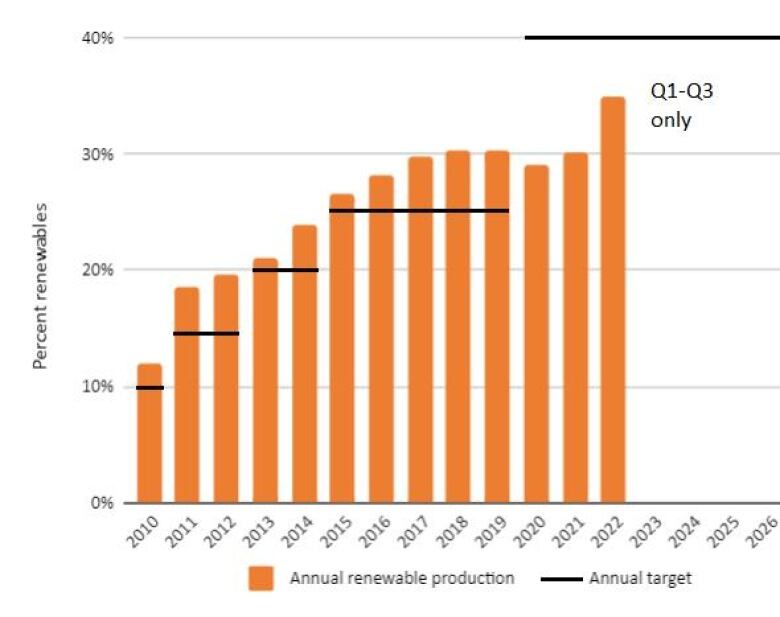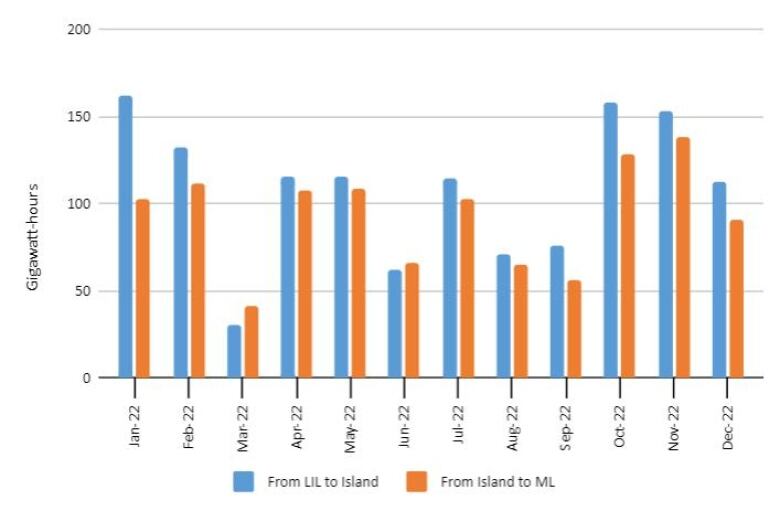N.L. Hydro is now meeting its obligation to Nova Scotia Power. But what about N.L.?
In 2022, Muskrat Falls provided less than one-third of expected gigawatt-hours to N.L., writes Larry Hughes

This column isby Larry Hughes, a professor at Dalhousie University in Halifax. For more information aboutCBC's Opinion section, please see theFAQ.
One of the lessons of the Churchill Falls project was to have a market for the electricity before starting construction.
The Muskrat Falls project seemed to fit the bill. In 2010, the Nova Scotia government introduced regulations requiring Nova Scotia Power to increase its use of renewables, from nine per centin 2010 to 25 per centbetween 2015 and 2019, and 40 per centfrom 2020 to 2030.
Nova Scotia Power was able to exceed the targets specified in the regulations by adding wind backed up by its limited hydroelectric capacity and natural gas. However, to meet the 2020 target of 40 per centrenewables, it was clear that to maintain system reliability, the utility would need a large source of electricity outside the province.
Muskrat Falls was seen as the perfect solution;not only was it to produce renewable electricity, it was to do it by 2020. In 2010, it was seen as a win both for Newfoundland and Labrador and Nova Scotia.
Things started out well enough. Between 2010 and 2019, Nova Scotia Power exceeded its annual renewable targets every year; however, from 2020 onward, the availability of electricity from renewables was less than Nova Scotia Power's 40 per centrenewables target.

The cause of the shortfall was the Muskrat Falls hydroelectric facility and its associated transmission infrastructure failing to produce electricity as planned by 2020.
By 2020, Nova Scotia Power had expected to receive 1,130 gigawatt-hours of electricity a year from Muskrat Falls. This volume comprised the Nova Scotia Block (890 gigawatt-hours or 20 per cent of the output of Muskrat Falls for 35 years) and the Supplemental Block (240 gigawatt-hours for the first five years).
This would have brought Nova Scotia Power up to the 40 per centtarget and allowed it to bring more variable renewables such as wind and solar onto the provincial grid.
Repeated assurances from Newfoundland and Labrador Hydro notwithstanding, any electricity from Newfoundland and Labrador made a negligible impact on Nova Scotia Power's supply of renewables in 2020 and 2021.
And Emera (Nova Scotia Power's parent company) was not making it public. Starting in the third quarter of 2021, Emera's quarterly Management Discussion and Analysis reports no longer listed the sources of Nova Scotia Power's purchased renewable electricity (notably Independent Power Producers or the Nova Scotia Community Feed-in Tariff, known as COMFIT).
However,the percentage of renewables began to increase in 2022 (the 2022 data does not include Nova Scotia's fourth-quarter renewables).
Sowhat has happened in Newfoundland and Labrador to see this seemingly unexpected increase in Nova Scotia Power's supply of renewables?
Despite an apparently endless stream of software faults, vibrating synchronous condensers, and collapsing transmission towers caused by failed turnbuckles, the Labrador-Island Linkis carrying about 30 per cent of the electricity expected from Muskrat Falls to the island of Newfoundland.
We know this because each month, N.L. Hydro publishes its electricity imports from Muskrat Falls (over LIL) and its exports to Nova Scotia (over the Maritime Link).In 2022, imports totalled just over 1,300 gigawatt-hours, while exports wereabout 1,119 gigawatt-hours.

The electricity exported by N.L. Hydro to Nova Scotia comes from a variety of sources, primarily Muskrat Falls, but also "bulk surplus" electricity, small hydro, Corner Brook Pulp and Paper, and "emergency supplies."
The volume of electricity used by N.L. Hydro to meet its Nova Scotia Block and Supplementary Block obligations is just over 1,130 gigawatt-hours. The difference between the actual exports (1,119 gigawatt-hours) and the volume supplied to the Maritime Link are transmission losses.
In other words, in 2022, N.L. Hydro scraped up enough electrons to meet its obligations to Nova Scotia Power.
While this is undoubtedly good news for Nova Scotia, the same cannot be said for Newfoundland and Labrador.
By now, N.L. Hydro should be receiving an average of about 370 gigawatt-hours a month from Muskrat Falls. In 2022, it received about 110 gigawatt-hours a month.
The shortfall and the fact that most of the electricity is sent to Nova Scotia simply adds insult to the $13-billion injury inflicted on Newfoundland and Labrador by the Muskrat Falls and LIL project.
Meanwhile, many people are skeptical that LIL can reliably supply power in the foreseeable future.
Newfoundland and Labrador deserves better.












_(720p).jpg)


 OFFICIAL HD MUSIC VIDEO.jpg)
.jpg)



























































































